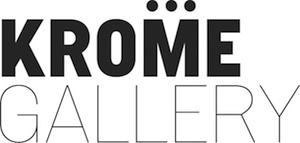•
MICHAEL HAKIMI
NEWSBLAST
26.09. – 21.11.2009
Opening: Friday 25.09.2009, 6 – 9 pm
•
click the picture to launch gallery
Krome Gallery will be showing “Newsblast”, Michael Hakimi’s (born 1968) first solo exhibition in Berlin, following up on his site-specific installation “Resonance”, conceptualized especially for the rooftop of the gallery last year.
Michael Hakimi will exhibit a varied ensemble of individual works, whose multiple formats voluminously extend throughout the gallery space. Three-dimensional images composed of lacquered MDF, molded concrete sculptures and an installation assembled from bits of newspaper come together to form a landscape of tactile maneuvers and spatial strategies. These works, predo-minantly black and white and mostly consisting of elementary geometric forms, self-reflexively analyze their precondition as objects, forms and re-presentations. However, they simultaneously deploy a bombardment of illu-sory, sensational and narrative after-effects, insisting on an encounter that digs below the visible surface. Between the lines of visuality and thought traced by each of these works, there develops a subtle web of formal relations and contextual allusions to a scopious spatial narrative.
•
The weeks leading up to the 2009 Iranian presidential elections and its immediate aftermath were witness to an unprecedented convergence of conflic-ting forces and visions of the future, perhaps last seen (albeit in a different form) in the 1979 Iranian Revolution. With the exhibition “Newsblast”, Haki-mi utilizes an ambivalent approach to subtly inscribe in his work the presence of the variety of major and minor media present in the ongoing post-electoral events. Seldom has there been, among all actors involved - whether citizen journalists, broadcasters or the public, such a clear dependence on the repre-sentation and distribution of images and the potential for risky categorizati-ons and (mis)interpretations: the self-organization of protesters and their media-conscious self-staging, the instrumentalization of mobile phones and the Internet technology to document and distribute what was witnessed, the shutting down of major reformist newspapers, the heavy filtering of websites (particularly social networking sites), the scrambling of international satelli-te dish signals, the temporary blockage of mobile telephone networks, and, in a final maneuver to clamp down on all opposition, the arrest of demonstra-tors, journalists and researchers (foreign and Iranian). Despite the numerous challenges that the Iranian people faced after the elections, their strategies have remained flexible: repressive censorship saw a simultaneous cultivati-on of conversation as a powerful means to share knowledge; mouth to mouth news chains replaced text-messaging and Facebooking; furthermore, rumors gained an astounding ability to produce intuitive information. Although go-vernment organs, such as conservative newspapers and state-run television and radio, initially ignored the post-electoral situation, they quickly deployed a heavy propaganda campaign, consisting mainly of a series of Stalinist-show
trials broadcasted live on TV, forced confessions from the arrested, and in-structional, “documentary” style programs re-narrating the events for adults as well as children, in order to counter-attack the wildfire of informal media.
The violent and dangerous climate produced by the (re)construction of reality through major media found itself reflected in the form of a highly subjective, month-long state of exception for individual users, readers and viewers in front of their computers, television screens or windows. The acutely intensive aftermath of the most recent events engendered, in its singling out of fine details, a particular form of inwardness: high levels of stress and concentrati-on were interrupted by the twists and turns of the events as they developed, a rollercoaster of emotions oscillating between hope and fear, euphoria and resignation, solidarity and loneliness, a constant shifting of perspectives.
In the course of events, the opposition between the individual and the me-dia intensified. On the one hand, the individual inevitably experienced waves of emotion, complete with psychosomatic repercussions; on the other hand, the media employed journalistic tools, utilizing "standardized" formats and cate-gorizations of functionality and objectivity in its coverage. Combined, this tension led to an ever more increasingly difficult to solve contradiction.
German-Iranian artist Michael Hakimi, who has been following the post-electoral situation in Tehran as well as in Berlin, tries to relate to this ambi-valence in the exhibition “Newsblast”. It is important for him to use his per-sonal artistic vocabulary, in which similar contradictions of visual represen-tation are constantly being negotiated, to extend spatially an atmospheric image that attempts to re-categorize the above-mentioned connections and make them productive. Hakimi’s seemingly sparse and catastrophic image-scape of ruinous shapes and structures plays with the basic parameters of representation and visual perception as well as with the mediated image-discourse of the news. In the delicately balanced arrangements and interde-pendences of these seemingly simple works in the space, an idiosyncratic grammar of forms arises that, as the basis for a narrative, immediately be-gins to tell a tale.
The exhibition departs from the coordinates of a spatial compass composed of unfolded newspapers that have been placed in the corners of the room, whose edges have been outlined with black spray paint. The drafted re-enactment of the space appears to refer back to its origin as an architectural layout or blueprint while simultaneously functioning as a link between the “virtual” two-dimensionality of print matter and the “real” three-dimensionality of the gallery. Nearby, a blackboard, similarly scaled and covered in punched-out holes, acts perhaps as a witness to the aftermath of a shooting, or maybe it is just in a state of irreparable decay. Quite noticeably, what remains of a white enamel letter “A” is painted onto the blackboard, transforming this object into, presumably, part of a much larger billboard or message. On the ground there lies a scattering of ovular, convex-shaped, concrete lenses, invoking the moulds needed to produce large, concave satel-lite dishes. The only painting in the exhibition presents the only exception: what ominously portends to be a glowing light behind a mountainous horizon is actually the spray-painted, negative imprint of a torn strip of paper, acting here as a stencil.
•


